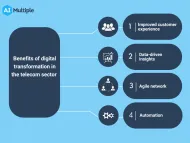Guide To A Resilient & Composable Business in 2024
The Covid-19 pandemic caused serious disruptions for businesses and healthcare systems worldwide. Government bodies and organizations had to rapidly change their traditional operations to respond to these disruptions. Similarly, companies such as Unilever and P&G had to pivot their focus on offerings according to the changing situation.
Businesses soon realized that their ability to pivot was weak. They needed to move towards more flexibility and resiliency to adjust to the new-normal and changes that might be here to stay.
This article explores why businesses need to move towards a composable business model and how they can achieve composability to secure their future in an ever-changing world.
Why is composability the future of business?
By adopting a composable business model, organizations can not completely avoid future disruptions and uncertainties. However, it can help prepare their business to convert these uncertainties into opportunities to achieve greater value and success. According to a survey, the focus on composable infrastructures is relatively less than other technologies (Figure 1). However, Gartner calls business composability a “key feature for a successful business”.
Figure 1. Global activities for technology initiatives in companies
Source: Statista
Higher agility and better response to disruptions
Successful businesses understand the need for immediate change and agility. Composable businesses are based on independent modular components which can be separately adjusted and changed, making companies ready for disruptive change. A composable business can immediately respond to a demand surge for existing products or test and offer new products and services with agility.
During the pandemic, Services Australia, a provider of welfare services to the citizens, faced a sudden rise in demand which crashed their systems and created disruptions in the business. However, the organization demonstrated composable business resilience and responded by quickly changing their traditional ways of operating and upgrading their system to accommodate the new traffic.
Another successful pivoting example is the transition of a Chinese appliance manufacturing company Gree Electric, from making electronic appliances to making medical equipment shortly after the pandemic created shortages in hospitals and the market.
More flexible infrastructure
A business built on a composable infrastructure can provide more flexibility to the company’s digital development. In addition, this infrastructure allows the implementation of API-driven resources, which allow the business to keep up with the continuously changing technology.
How to implement composability in your business?
The four principles of business composability
Gartner explains a composable business as “a business made with interchangeable building blocks” and provides four principles that summarize business composability. Your strategy to implement business composability in your business must contain these four principles. These principles are; discovery, orchestration, autonomy, and modularity.
- Discovery: This refers to the business’s ability to quickly discover the change.
- Modularity: With modularity, a business can achieve greater agility through its interchangeable components.
- Orchestration: This refers to the ability of the leadership to orchestrate the response to the change.
- Autonomy: Through these principles, a business can achieve higher resilience through its autonomous or independent business components.
Figure 2. Four principles of business composability
Start with composable thinking
Implementing a composable business model requires a change of mindset. Businesses need to first think about their future business needs and create a flexible and modular architecture to help meet those needs.
First, a business needs to start by defining a composability vision that gives a clear picture of the future of the business. Thinking about the following points can help:
- The future of the business’s market for the next 5 years.
- The competition in the market and how it might change.
- Possible future changes in customer expectations and behavior.
- How can the business achieve a competitive advantage through new products, services, processes, and innovation?
- Possible future expansion into new markets or adoption of new business models and strategies.
Considering these points will give a clear picture of the possible multiple futures that the business might have and help implement a composable philosophy in every business component.
Implement composable technologies
Composable technologies act as the tools which help execute the composable vision. Therefore, it is essential for business professionals to implement composable technologies in their digital transformation process.
Composable architecture for composable technology
Businesses should first shift from monolithic digital architecture to composable architecture. This can be achieved by
- Increasing flexibility in the ecosystem,
- Implementing APIs,
- Considering infrastructure as a separate component through infrastructure as a service (IaaS),
- Implementing infrastructure automation,
- Implementing multi-cloud strategies.
Packaged business capabilities (PBCs)
Another way of leveraging composable technology is implementing PBCs, which are a collection of microservices or software components catering to specific business needs. PBCs can be created, assembled, adjusted with agility and can help change a business’s digital capabilities according to the changing business needs.
PBCs can either be created internally or outsourced depending on your business needs and scope. For instance, if the technology is standard in businesses and is readily available through vendors, outsourcing would be wiser and more cost-effective. On the contrary, if the business need is unique, creating the PBC internally would be a better choice.
Further reading:
To successfully implement digital in your business for more business composability, check out:
- Digital Transformation Frameworks from Top Consulting Firms
- Top 7 Digital Transformation Best Practices for the Organizations
- Digital Transformation in different sectors
- Digital Transformation Case Studies and Success Stories
You can also check our sortable/filterable list of digital transformation consulting companies to find the fit that best suits your business needs.
If you have questions about business composability, let us know:



Comments
Your email address will not be published. All fields are required.